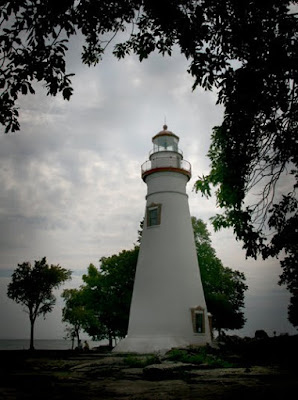
A horseback statue of General Phil Sheridan—the only such Civil War statue in Ohio—dominates the square in Somerset while (below) lady friend Sue Brooks and sister Patsy Love are attended to in the Clay Haus restaurant. Shortly after this picture, church bells rang and the room was filled with diners.
 GREAT FOOD, A GENERAL AND A GHOST OR TWO—
GREAT FOOD, A GENERAL AND A GHOST OR TWO—Somerset is a quaint Ohio village with two delightful surprises for the casual visitor. Drive south on Ohio 13 into Perry County and you will run smack into the town’s traffic circle and a large statue of horseback, Civil War General, Phil Sheridan who grew up there.
In that war he wound up being General Ulysses S. Grant’s right hand man and was largely responsible for defeating General Robert E. Lee’s army and consequent surrender at Appomattox.
Not a bad legacy for a country fellow who stood a mere 5’ 5” tall and about whom Abe Lincoln once quipped, he has “...such long arms that if his ankles itch he can scratch them without stooping.”
To the general’s left is the Clay Haus, just a wee bit down US 22 toward Lancaster, once a private residence from the early 1800s and now a marvelous eatery that absolutely engulfs visitors in history—and sumptuous food with a decided German flavor.
I eagerly filled my plate with sauerkraut and sausage, dressing and home-made noodles, so fast, in fact, I had to go back to the buffet and make my salad a second course of this delicious meal. After a hefty chunk of lemon cream pie with a dollop of whipped cream I was satisfied even if my next meal didn’t come until the following Tuesday.
During renovation of the old residence into the restaurant in 1978 it was discovered the outside door and front windows of the street-facing wall in the basement now faced a solid wall of foundation stones and brick. Evidently what once had been the street level entry to the home had been filled making the second floor of the structure the new entry level.
Another feature of the historic home restaurant is, well, ghosts. Scott Snider who manages the place for the Snider family is quoted in the
Ghost Hunter’s Guide to Haunted Ohio that even talking about such ghostly activity makes the hair on his arm stand up.
My lady friend Sue Brooks and I were in town to meet her sister, Patsy Love, both of whom grew up on the family farm just outside of Junction City, the next town south, more or less. In fact, Patsy still lives on the old homestead.
Before lunch Sue was showing me the interior of the town’s modest grocery—which she clearly remembered as being their movie theater in the 1950s. There we ran into Kevin Snider, no relation to Scott, who shared lots of remembrances with Sue.
Our task that day was to pick up a couple of church pews for mutual Mansfield friend, Don Karger, which were in Patsy’s custody--the pews, not the friend. The pews came from a now demolished country church once attended by past generations of the Love family.
Turns out, the church building had been long abandoned then struck by two bad storms recently which led to the necessity of its demolition. While we stood in the cemetery which surrounded the sandstone foundation of the old church, Patsy pointed to a church building on a nearby hill.
“That congregation once was part of this church,” she reminisced. “But they had troubles and a split occurred.”
You learn such things about the tapestry of life when you simply take time for a visit to small town USA.
______________________
Curious:
http://clayhaus.com/



















 ___________________________
___________________________

